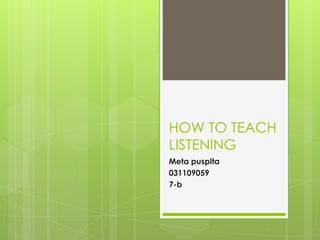
How to teach listening 1
- 1. HOW TO TEACH LISTENING Meta puspita 031109059 7-b
- 2. CONTENT Definition Why teach listening? Teacher‟s and students‟ difficulties Top tips A successful listening activity Listening exercises
- 3. LISTENING Listeningis the ability to identify and understand what others are saying. This involves understanding a speaker's accent or pronunciation, his grammar and his vocabulary, and grasping his meaning (Howatt and Dakin). An able listener is capable of doing these four things simultaneously.
- 4. WHY TEACH LISTENING? Students hear different accents and varieties. Listening helps students to acquire language subconsciously. Listening is a receptive skill. Education. Mass communication.
- 5. „WHAT A DIFFICULT TASK…‟ Teaching listening skills is one of the most difficult tasks for any ESL teacher. Sometimes students feel frustrated because they find listening difficult… Why?
- 6. DIFFICULTIES Students are trying to understand every word. Students go back trying to understand what a previous word meant. Students just don‟t know the most important words. Students don‟t recognize the words they know. Students have problems with different accents. Students get tired. Students have mental block. Students are distracted. Students cannot cope without images. Students have hearing problems.
- 7. TOP TIPS PRE- LISTENING: Tell your students “ DON‟T WORRY” Make sure students know what they are listening for before you start listening Give questions to check students comprehension Check for any words that your students may not know
- 8. Check for any words that your students may not know Short listening Stop the recording
- 9. WHILE LISTENING: Try to play the recording once for overall comprehension and then for specific details. Take notes ( dates, places, people) Repeat the recording especially in the difficult parts
- 10. POST-LISTENING: Compare their notes in small groups. Encourage debates and answer questions. Write a summary of the main points and then compare. Make a list of any new vocabulary.
- 11. REMEMBER!!! Try to use as many different sources of listening material as you can: advertisements, news programs, poetry, songs, extracts from plays, speeches, lectures, telephone conversations, informal dialogues.
- 12. A SUCCESSFUL LISTENING ACTIVITY Ideas to make the best listening activities ever!
- 13. 1 Reduce distractions and noise during the listening segment.
- 14. 2 makesure the equipment produces acceptable sound quality.
- 15. 3 Read or play the text a total of 2-3 times.
- 16. 4 Playa video clip with the sound off and ask students to make predictions about it.
- 17. 5 Give students a listening task to do between classes.
- 31. SOURCES http://iteslj.org/Articles/Saricoban-Listening.html http://writing.colostate.edu/guides/teaching/esl/listenin g.cfm http://es.scribd.com/doc/14427811/How-to-Teach- English-Jeremy-Harmer http://esl.about.com/cs/teachinglistening/a/a_tlisten.ht m http://www.usingenglish.com/teachers/articles/why- your-students-have-problems-with-listening- comprehension.html
